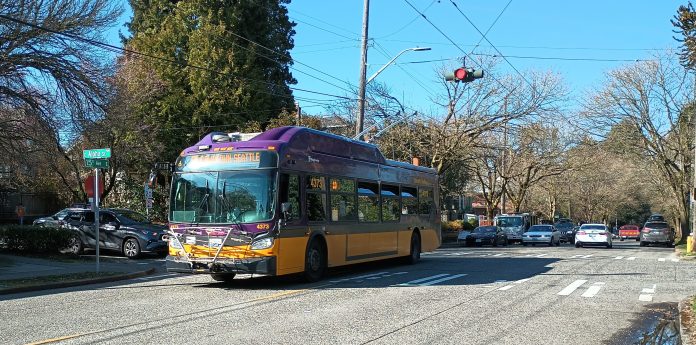
RapidRide G Line will have lots of capacity during the day, but evenings and connections get dicey.
Next year, the Seattle Department of Transportation (SDOT) and King County Metro will cut the ribbon on the RapidRide G Line. The change is one of the most substantial overhauls of a bus corridor that the region has ever seen as Madison Street between 1st Avenue and Madison Valley converts into a bus rapid transit (BRT) corridor with exclusive priority for buses along most of its length. The $133 million project has been in the works for nearly a decade, one of the top recommendations to improve transit service from Seattle’s 2016 Transit Master Plan.
As construction reaches a halfway point, King County Metro is preparing for how other bus routes in the vicinity of the G Line may change in response to service starting on the new corridor. They are asking riders and neighbors for input around the changes.
Unlike this month’s conversion and upgrade of Route 120 to RapidRide H Line for its entire length between Downtown and Burien, the G Line will take over for segments of two separate bus routes: Routes 11 and 12. More than just one route will need to be modified, impacting more bus riders in Capitol Hill, the Central District, Madison Valley, and First Hill than just the ones currently catching buses on Madison.
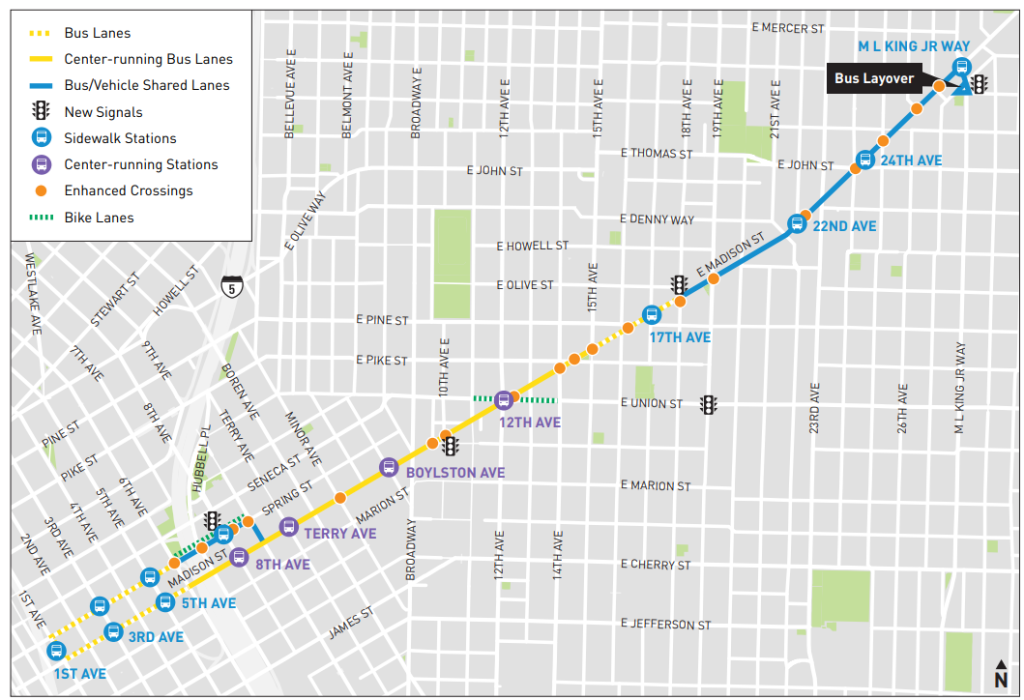
If the G Line were launching in the pre-pandemic rapid bus expansion context in which it was conceived, the conversation around the G Line might be very different. At that time, Metro could consistently add service thanks in large part to Seattle’s dedicated transit benefit district. Instead we find ourselves in a significant bus operator hiring crunch. Following in the footsteps of other recent bus restructure proposals around new light rail stations, Metro is in the position of having to make some tough choices about where to reallocate service.
There are some unique constraints at play here. According to Metro, the agency expects to be able to invest about 26,000 additional annual service hours in the vicinity of the G Line when it launches. But the lion’s share of those hours will be devoted to meeting the G Line’s ambitious frequency goals, as laid out in an agreement between Metro and SDOT as part of the 2021 Small Starts grant agreement with the Federal Transit Administration.
That agreement commits Metro to providing six-minute service — 10 buses per hour — between 6am and 7pm, every day except Sunday. That’s a big increase for trips along Madison itself compared to the routes the G Line is replacing, the 11 and the 12. After 7pm, service is kept very close to where it is now, with four buses per hour. (So make sure to leave for your 7:30pm show at the 5th Avenue Theater a little early.)
With late night service, it’s still unclear what level of frequency nightlife goers in Capitol Hill could expect from the G Line. We only know that after 10pm, buses will come somewhere between every 15 and 40 minutes. On Sundays, the dedicated transitways along Madison will only get used four times per hour all day. Ultimately, it’s midday riders, along with those in the AM and PM peak, who will see the most G Line trips.
In order to meet those ambitious “most” day frequencies, Metro’s proposed restructure would reduce frequencies on other routes, some of which don’t even connect with the G Line. And that’s where we run into the most difficult parts of the plan to swallow.
A Scaled-Down Network Reroutes Riders Away from Link
Under Metro’s proposal, the Route 10, which currently runs along Pike and Pine downtown and then up Olive Way to head to Volunteer Park via the 15th Avenue business district, would be rerouted away from Capitol Hill Station, despite not interacting with the G Line in any way. Instead it would run all the way up Pine Street to 15th Avenue. This restores transit to a part of Capitol Hill that lost direct bus service in 2016, 15th Avenue between Pine and John, in order to give riders direct access to light rail.
It’s not entirely clear why that benefit no longer exists, but the real blow to the 10 is that frequency would be reduced to “at least” 30 minutes compared to its current 15-minute frequency throughout most of the day. Riders heading home from Volunteer Park would have to wait twice as long for their bus, and don’t even have a direct connection to either Capitol Hill Station or the G Line on their route.
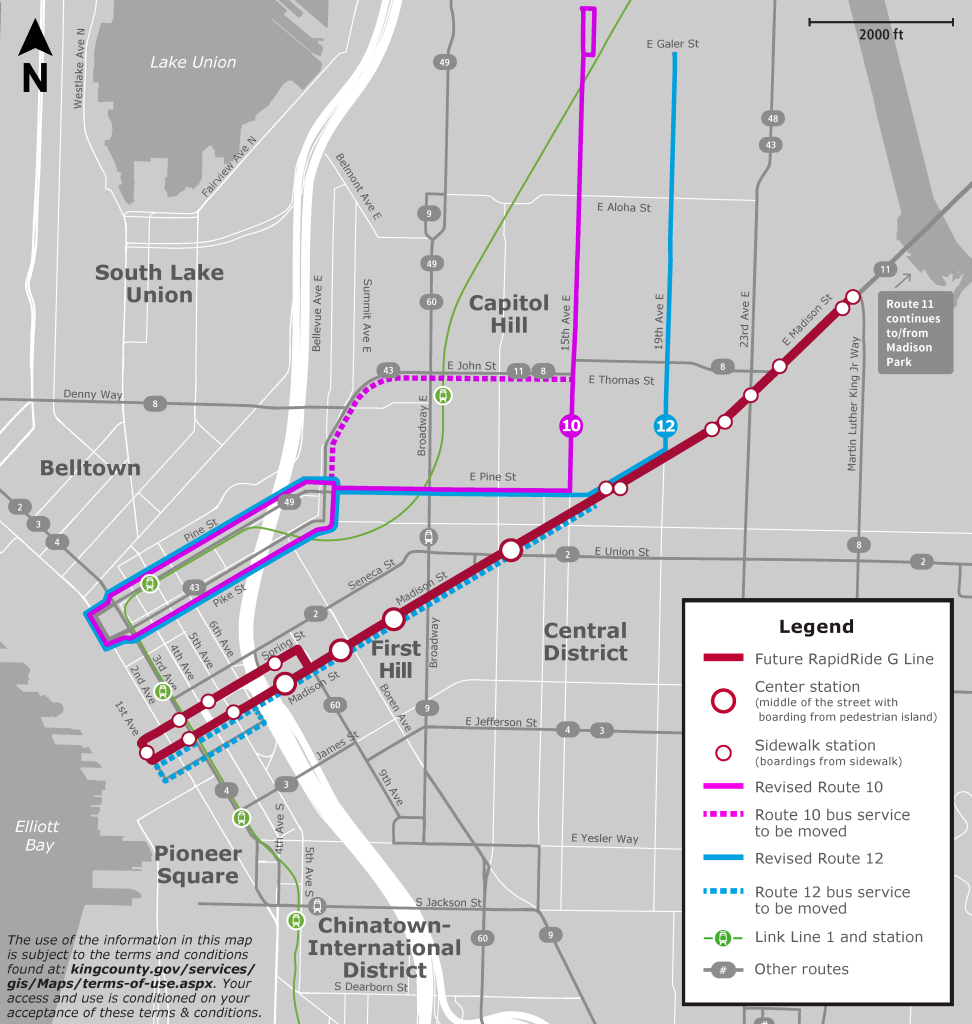
The shift of the 10 to Pine Street seems primarily designed to make up for the loss in frequency along Pike Street, with Route 12 (currently running along Madison Street) shifting over to Pike but also going to frequencies of “at least” 30 minutes, another big downgrade. Combining these routes together, but only along Pike Street up to 15th Ave, provides close to the original 15-minute frequencies that were lost, but that’s limited by the low frequencies of the routes on their own.
Service along Olive Way, connecting to Capitol Hill Station, would be replaced by the Route 11, which currently runs along Pine Street and Madison Street all the way to Madison Park. This route might look very different if the G Line ran all the way to Madison Park itself, but stopping in Madison Valley means a full local bus connection is needed. The 11 wouldn’t see as much of a service cut as the 10 or the 12, but would go to frequencies of at least 20 to 30 minutes.
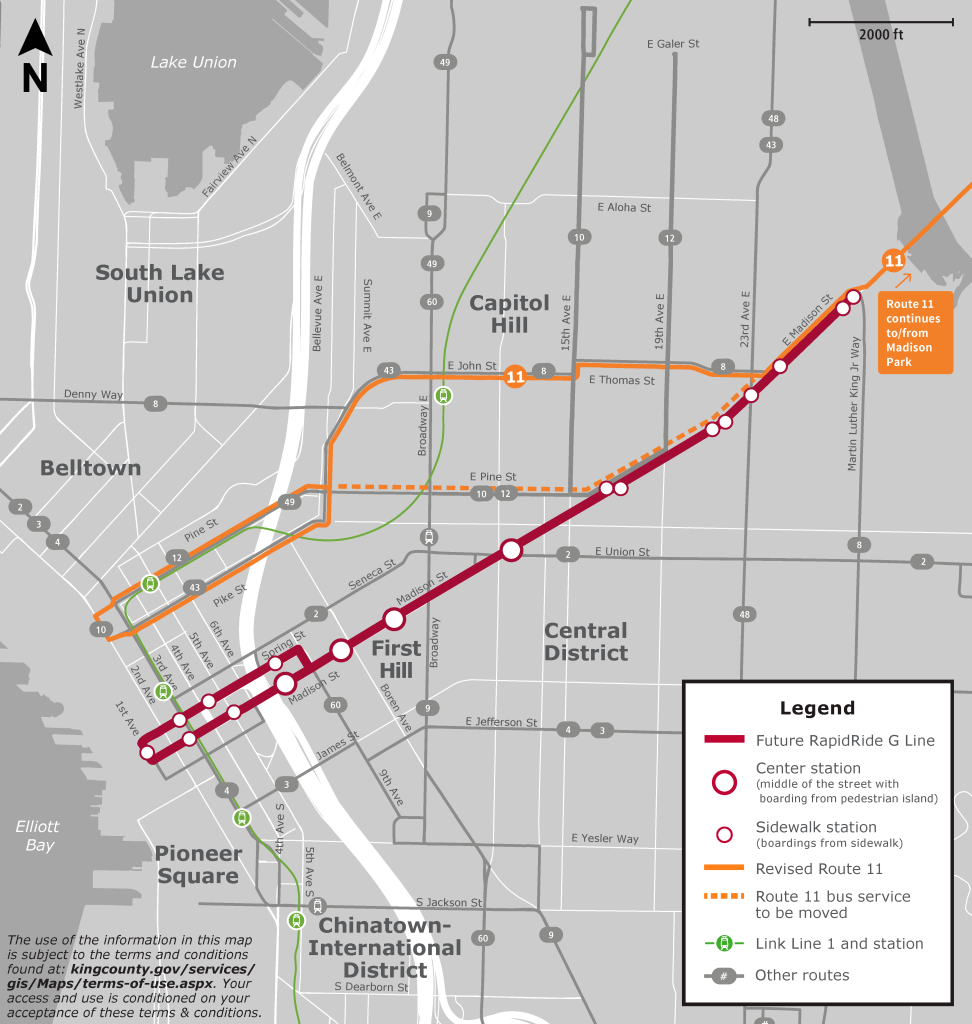
Ultimately, the bus network will only be as good as its connections. Riders attempting to use the G Line to make connections to other routes will find their options severely limited. The benefit of beefing up service on the G Line is severely constrained if riders have to wait 30 minutes for a connection. In making a step toward more frequency on one of its highest potential ridership lines, Metro proposes two steps back in terms of the overall network.
On top of that, the G Line will include fewer stops than current buses on Madison Street, making some of the connections that do exist, like those to the First Hill Streetcar, even more onerous.
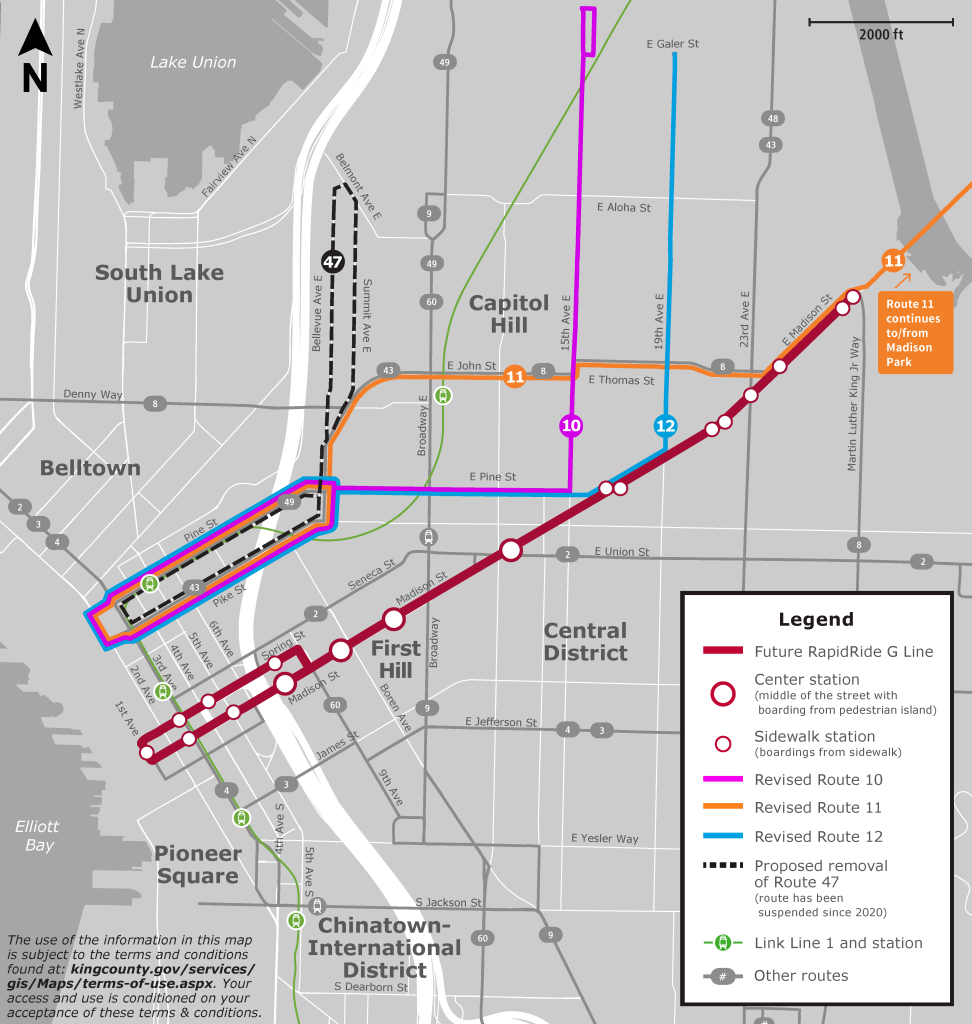
Key Routes Left Untouched
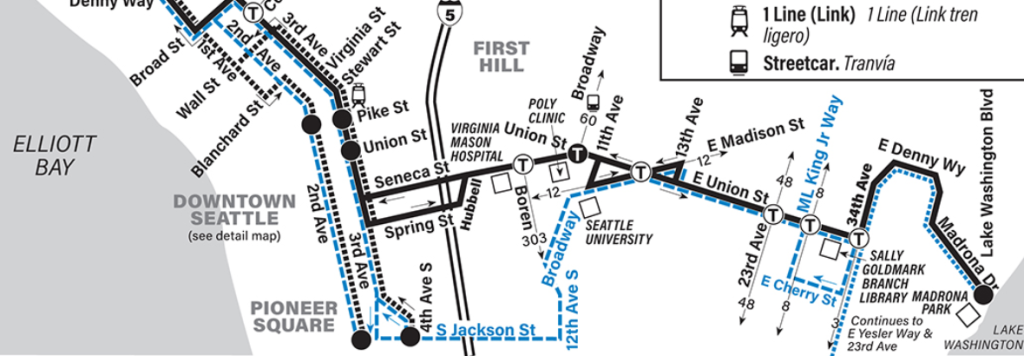
The proposed network changes leave some heavy hitters relatively unchanged in the vicinity of the G Line, most notably the Route 2, which runs very close to the G Line in First Hill before splitting off down Union Street to serve the Central District and Madrona. A few blocks away from the 2, buses will be coming and going every six minutes on Madison Street, but few current 2 riders will have much reason to switch buses. How strange that riders far from the Line G on the north end of 19th Avenue and 15th Avenues will see service cuts due to the G Line but riders on the Route 2 will not.
Route 49, which doesn’t connect with the G Line but will follow the same routing as the 10 and the 12 along Pine Street, is less duplicitive but adds another bus still making many trips a day between downtown and Capitol Hill while trips to other parts of the neighborhood are cut. Whether this is really the best use of the scarce service hours available is a question that needs to be asked.

But it’s hard to argue that the 2, or the 12, or any of these well-used routes should be modified to terminate at the G Line, primarily because of the drop to 15-minute service after 7pm. Terminating bus routes at Link stations makes some degree of sense because Link almost always has more frequency than those buses, something that won’t generally be true later in the evening. And so the proposed service frequencies on the G Line are a big limitation even as the midday increases will benefit a lot of riders.
The Official Death of the 47
Metro’s survey also proposes to permanently eliminate a long-established trolleybus route in east Capitol Hill: the Route 47. Suspended during the early days of the Covid-19 pandemic, the route had been previously suspended by Metro due to low ridership in 2014. It was restored by the Seattle transit measure voters passed that fall with very limited peak hour service. But during a time of scarce resources, Seattle’s criteria for service investments prioritizes other routes over the 47, as do Metro’s overall service guidelines. The short route, which is duplicative with other routes apart from a stretch of around eight blocks on Bellevue and Summit Avenues, has remained in limbo.
The 47 is a victim of other, much better transit options in the neighborhood, including the 49, Olive Way service, and Link. A great deal of riders who might use the 47 to get downtown have a big incentive to walk to a different option. It’s hard to advocate for the return of the 47.
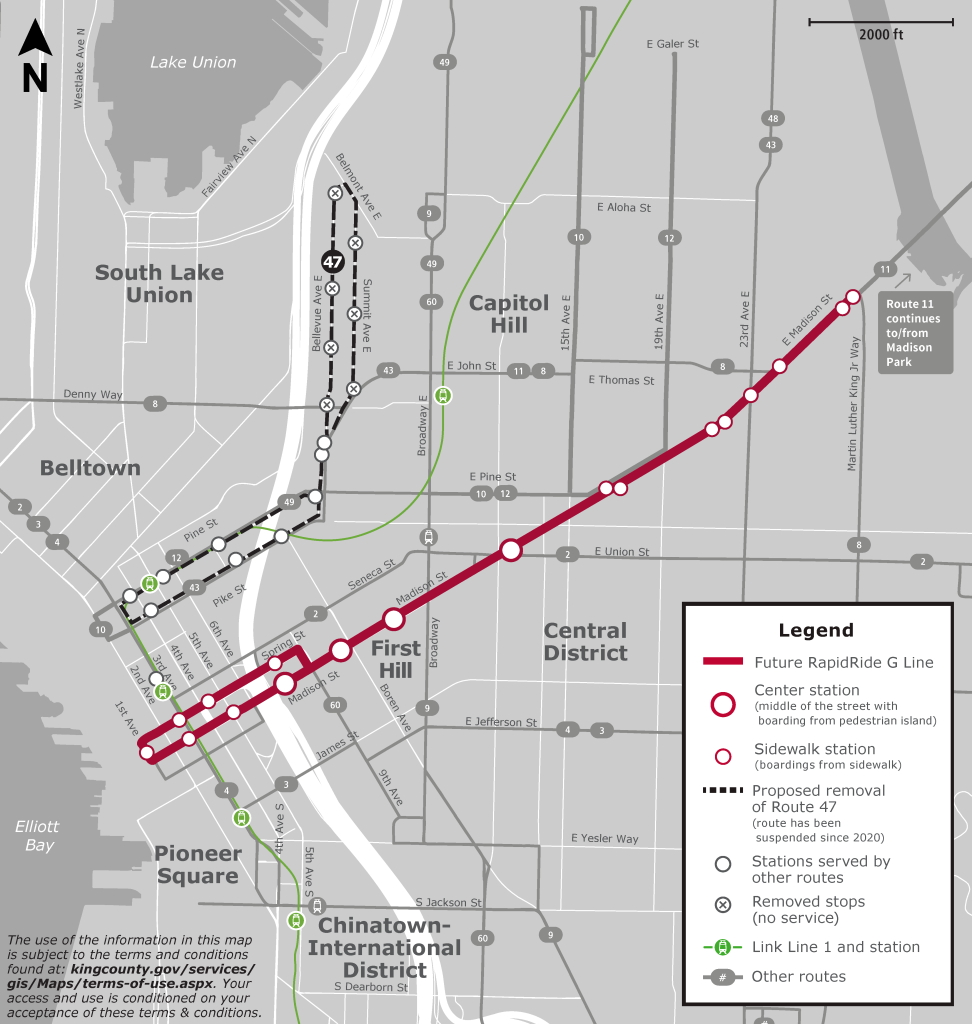
The 47 has a long history in Capitol Hill, originally running as a streetcar up Summit Avenue since at least the early 1920s. Fully eliminating the 47 means getting rid of multiple blocks of trolleywire, a disappointing event in and of itself. But ultimately, service needs to go where it will benefit the most riders.
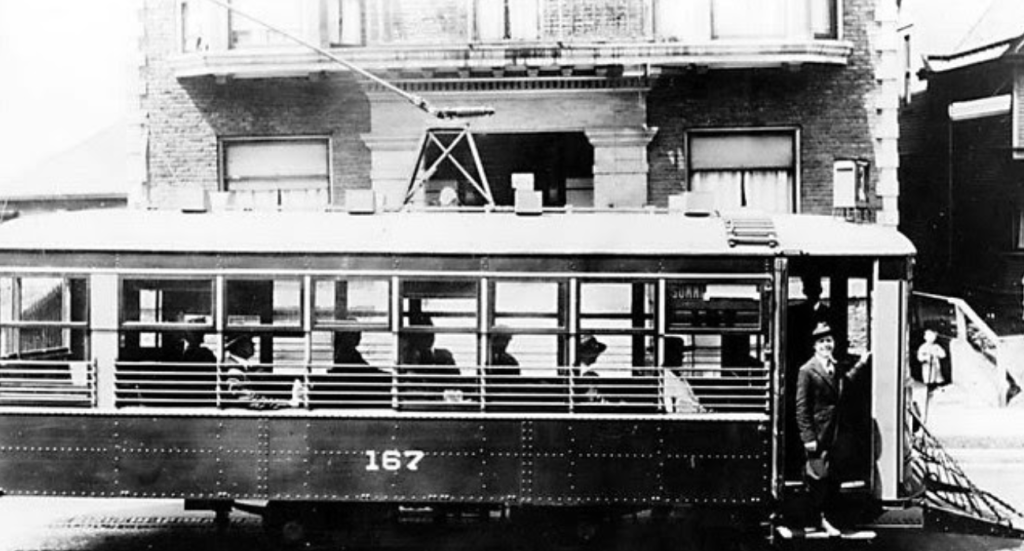
King County Metro has been put in a tough position to deliver on incredibly frequent service along Madison with the G Line’s start of service. But many elements of the proposed restructure set the system up to have 10 buses per hour that no one can get to because connections are so infrequent. The reorganization takes a step back from earlier goals of connecting Capitol Hill residents to light rail. It raises serious questions about how the agency will be able to ultimately deliver the all-day network that it says it wants to given constrained resources. Ultimately, the answer is being able to deliver more bus service. In the meantime, this will be a bitter pill to swallow, coming on the heels of such a big investment on Madison Street.
Metro’s survey on the proposed restructure is up until May 8.
Ryan Packer has been writing for The Urbanist since 2015, and currently reports full-time as Contributing Editor. Their beats are transportation, land use, public space, traffic safety, and obscure community meetings. Packer has also reported for other regional outlets including Capitol Hill Seattle, BikePortland, Seattle Met, and PubliCola. They live in the Capitol Hill neighborhood of Seattle.



